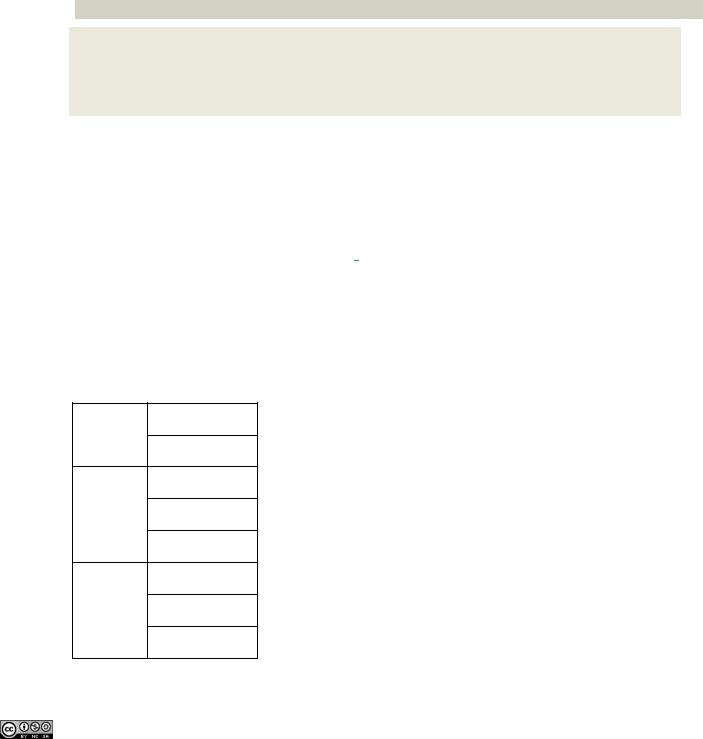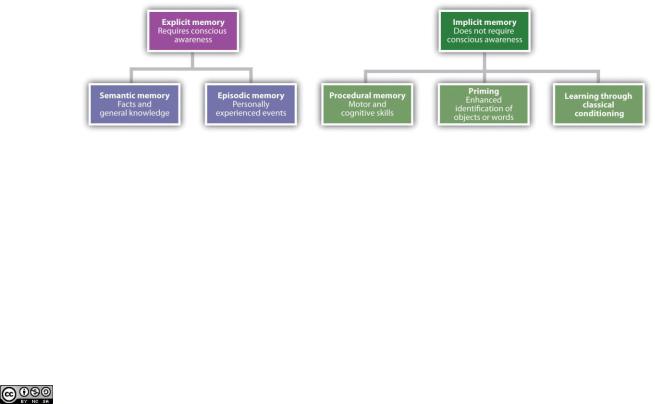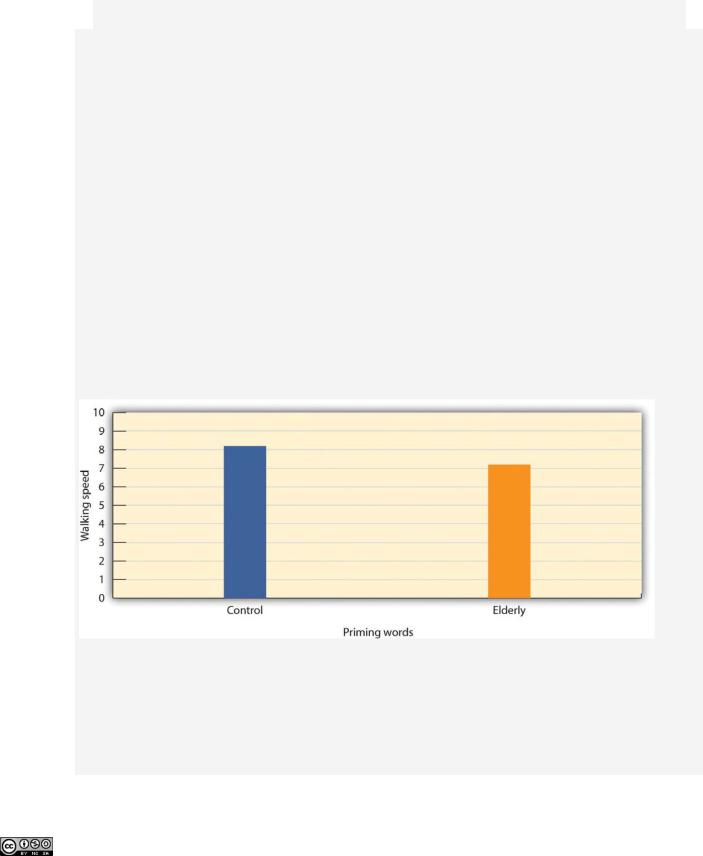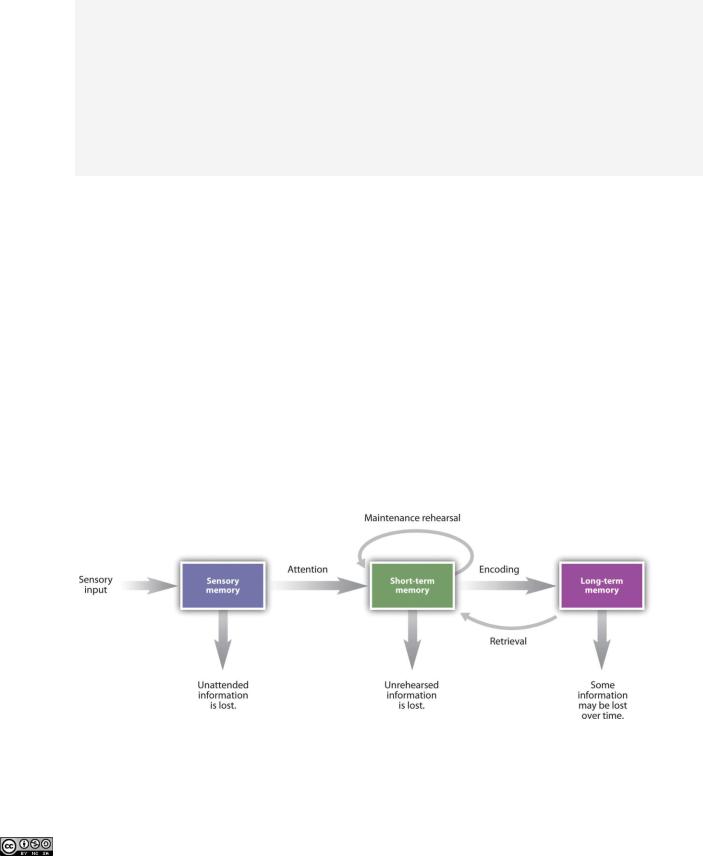
Психология
.pdf
For some people, memory is truly amazing. Consider, for instance, the case of Kim Peek, who was the inspiration for the Academy Award–winning film Rain Man (Figure 8.1 "Kim
Peek" andNote 8.5 "Video Clip: Kim Peek"). Although Peek‘s IQ was only 87, significantly below the average of about 100, it is estimated that he memorized more than 10,000 books in his lifetime (Wisconsin Medical Society, n.d.; “Kim Peek,‖ 2004). [6] The Russian psychologist A.
R. Luria (2004) [7] has described the abilities of a man known as ―S,‖ who seems to have unlimited memory. S remembers strings of hundreds of random letters for years at a time, and seems in fact to never forget anything.
Video Clip: Kim Peek
You can view an interview with Kim Peek and see some of his amazing memory abilities at this link.
In this chapter we will see how psychologists use behavioral responses (such as memory tests and reaction times) to draw inferences about what and how people remember. And we will see that although we have very good memory for some things, our memories are far from perfect (Schacter, 1996). [8] The errors that we make are due to the fact that our memories are not simply recording devices that input, store, and retrieve the world around us. Rather, we actively process and interpret information as we remember and recollect it, and these cognitive processes influence what we remember and how we remember it. Because memories are constructed, not recorded, when we remember events we don‘t reproduce exact replicas of those events (Bartlett, 1932). [9]
In the last section of the chapter we will focus primarily on cognition, with a particular consideration for cases in which cognitive processes lead us to distort our judgments or misremember information. We will see that our prior knowledge can influence our memory. People who read the words “dream,sheets, rest, snore, blanket, tired, and bed‖ and then are asked to remember the words often think that they saw the word sleep even though that word was not in the list (Roediger & McDermott, 1995). [10] And we will see that in other cases we are
Attributed to Charles Stangor |
Saylor.org |
Saylor URL: http://www.saylor.org/books/ |
391 |

influenced by the ease with which we can retrieve information from memory or by the information that we are exposed to after we first learn something.
Although much research in the area of memory and cognition is basic in orientation, the work also has profound influence on our everyday experiences. Our cognitive processes influence the accuracy and inaccuracy of our memories and our judgments, and they lead us to be vulnerable to the types of errors that eyewitnesses such as Jennifer Thompson may make. Understanding these potential errors is the first step in learning to avoid them.
[1] Innocence Project. (n.d.). Ronald Cotton. Retrieved fromhttp://www.innocenceproject.org/Content/72.php; Thompson, J.
(2000, June 18). I was certain, but I was wrong. New York Times. Retrieved
fromhttp://faculty.washington.edu/gloftus/Other_Information/Legal_Stuff/Articles/News_Articles/Thompson_NYT_6_18_2000.
html
[2]Wells, G. L., Memon, A., & Penrod, S. D. (2006). Eyewitness evidence: Improving its probative value. Psychological Science in the Public Interest, 7(2), 45–75.
[3]Chatham, C. (2007, March 27). 10 important differences between brains and computers. Developing Intelligence. Retrieved fromhttp://scienceblogs.com/developingintelligence/2007/03/why_the_brain_ is_not_like_a_co.php
[4]Bahrick, H. P. (2000). Long-term maintenance of knowledge. In E. Tulving & F. I. M. Craik (Eds.), The Oxford handbook of memory (pp. 347–362). New York, NY: Oxford University Press.
[5]Mitchell, D. B. (2006). Nonconscious priming after 17 years: Invulnerable implicit memory? Psychological Science, 17(11), 925–928.
[6]Wisconsin Medical Society. (n.d.).
; Kim Peek: Savant who was the inspiration for the film Rain Man. (2009, December 23). The Times. Retrieved from http://www.timesonline.co.uk/tol/comment/obituaries/article6965115.ece
[7]Luria, A. (2004). The mind of a mnemonist: A little book about a vast memory.Cambridge, MA: Harvard University Press.
[8]Schacter, D. L. (1996). Searching for memory: The brain, the mind, and the past (1st ed.). New York, NY: Basic Books.
Attributed to Charles Stangor |
Saylor.org |
Saylor URL: http://www.saylor.org/books/ |
392 |

[9]Bartlett, F. C. (1932). Remembering. Cambridge, MA: Cambridge University Press.
[10]Roediger, H. L., & McDermott, K. B. (1995). Creating false memories: Remembering words not presented in lists. Journal of
Experimental Psychology: Learning, Memory, and Cognition, 21(4), 803–814.
8.1 Memories as Types and Stages
LE ARNING OB JECT I VE S
1.Compare and contrast explicit and implicit memory, identifying the features that define each.
2.Explain the function and duration of eidetic and echoic memories.
3.Summarize the capacities of short-term memory and explain how working memory is used to process information in it.
As you can see in Table 8.1 "Memory Conceptualized in Terms of Types, Stages, and Processes", psychologists conceptualize memory in terms of types, in terms of stages, and in terms of processes. In this section we will consider the two types of memory, explicit memory and implicit memory, and then the three major memory stages: sensory, short-term, and long-term (Atkinson & Shiffrin, 1968). [1] Then, in the next section, we will consider the
nature of long-term memory, with a particular emphasis on the cognitive techniques we can use to improve our memories. Our discussion will focus on the three processes that are central to long-term memory: encoding, storage, and retrieval.
Table 8.1 Memory Conceptualized in Terms of Types, Stages, and Processes
Explicit memory
As types Implicit memory
Sensory memory
Short-term memory
As stages Long-term memory
Encoding
Storage
As processes Retrieval
Attributed to Charles Stangor |
Saylor.org |
Saylor URL: http://www.saylor.org/books/ |
393 |

Explicit Memory
When we assess memory by asking a person to consciously remember things, we are measuring explicit memory. Explicit memory refers to knowledge or experiences that can be consciously remembered. As you can see in Figure 8.2 "Types of Memory", there are two types of explicit memory: episodic andsemantic. Episodic memory refers to the firsthand experiences that we have had (e.g., recollections of our high school graduation day or of the fantastic dinner we had in New York last year). Semantic memory refers to our knowledge of facts and concepts about the world (e.g., that the absolute value of −90 is greater than the absolute value of 9 and that one definition of the word “affect‖ is ―the experience of feeling or emotion‖).
Figure 8.2 Types of Memory
Explicit memory is assessed using measures in which the individual being tested must consciously attempt to remember the information. Arecall memory test is a measure of explicit memory that involves bringing from memory information that has previously been remembered. We rely on our recall memory when we take an essay test, because the test requires us to generate previously remembered information. A multiple-choice test is an example of
a recognition memory test, a measure of explicit memory that involves determining whether information has been seen or learned before.
Attributed to Charles Stangor |
Saylor.org |
Saylor URL: http://www.saylor.org/books/ |
394 |

Your own experiences taking tests will probably lead you to agree with the scientific research finding that recall is more difficult than recognition. Recall, such as required on essay tests, involves two steps: first generating an answer and then determining whether it seems to be the correct one. Recognition, as on multiple-choice test, only involves determining which item from a list seems most correct (Haist, Shimamura, & Squire, 1992). [2] Although they involve different processes, recall and recognition memory measures tend to be correlated. Students who do better on a multiple-choice exam will also, by and large, do better on an essay exam (Bridgeman & Morgan, 1996). [3]
A third way of measuring memory is known as relearning (Nelson, 1985). [4]Measures
of relearning (or savings) assess how much more quickly information is processed or learned when it is studied again after it has already been learned but then forgotten. If you have taken some French courses in the past, for instance, you might have forgotten most of the vocabulary you learned. But if you were to work on your French again, you‘d learn the vocabulary much faster the second time around. Relearning can be a more sensitive measure of memory than either recall or recognition because it allows assessing memory in terms of “how much‖ or “how fast‖ rather than simply “correct‖ versus “incorrect‖ responses. Relearning also allows us to measure memory for procedures like driving a car or playing a piano piece, as well as memory for facts and figures.
Implicit Memory
While explicit memory consists of the things that we can consciously report that we know, implicit memory refers to knowledge that we cannot consciously access. However, implicit memory is nevertheless exceedingly important to us because it has a direct effect on our behavior. Implicit memory refers to the influence of experience on behavior, even if the individual is not aware of those influences. As you can see in Figure 8.2 "Types of Memory", there are three general types of implicit memory: procedural memory, classical conditioning effects, and priming.
Attributed to Charles Stangor |
Saylor.org |
Saylor URL: http://www.saylor.org/books/ |
395 |

Procedural memory refers to our often unexplainable knowledge of how to do things. When we walk from one place to another, speak to another person in English, dial a cell phone, or play a video game, we are using procedural memory. Procedural memory allows us to perform complex tasks, even though we may not be able to explain to others how we do them. There is no way to tell someone how to ride a bicycle; a person has to learn by doing it. The idea of implicit memory helps explain how infants are able to learn. The ability to crawl, walk, and talk are procedures, and these skills are easily and efficiently developed while we are children despite the fact that as adults we have no conscious memory of having learned them.
A second type of implicit memory is classical conditioning effects, in which we learn, often without effort or awareness, to associate neutral stimuli (such as a sound or a light) with another stimulus (such as food), which creates a naturally occurring response, such as enjoyment or salivation. The memory for the association is demonstrated when the conditioned stimulus (the sound) begins to create the same response as the unconditioned stimulus (the food) did before the learning.
The final type of implicit memory is known as priming, or changes in behavior as a result of experiences that have happened frequently or recently. Priming refers both to the activation of knowledge (e.g., we can prime the concept of “kindness‖ by presenting people with words related to kindness) and to the influence of that activation on behavior (people who are primed with the concept of kindness may act more kindly).
One measure of the influence of priming on implicit memory is the word fragment test, in which a person is asked to fill in missing letters to make words. You can try this yourself: First, try to complete the following word fragments, but work on each one for only three or four seconds. Do any words pop into mind quickly?
_ i b _ a _ y
_ h _ s _ _ i _ n
Attributed to Charles Stangor |
Saylor.org |
Saylor URL: http://www.saylor.org/books/ |
396 |

_ o _ k
_ h _ i s _
Now read the following sentence carefully:
He got his materials from the shelves, checked them out, and then left the building.‖
Then try again to make words out of the word fragments.
I think you might find that it is easier to complete fragments 1 and 3 as “library‖ and “book,‖ respectively, after you read the sentence than it was before you read it. However, reading the sentence didn‘t really help you to complete fragments 2 and 4 as “physician‖ and “chaise.‖ This difference in implicit memory probably occurred because as you read the sentence, the concept of “library‖ (and perhaps “book‖) was primed, even though they were never mentioned explicitly. Once a concept is primed it influences our behaviors, for instance, on word fragment tests.
Our everyday behaviors are influenced by priming in a wide variety of situations. Seeing an advertisement for cigarettes may make us start smoking, seeing the flag of our home country may arouse our patriotism, and seeing a student from a rival school may arouse our competitive spirit. And these influences on our behaviors may occur without our being aware of them.
Research Focus: Priming Outside Awareness Influences Behavior
One of the most important characteristics of implicit memories is that they are frequently formed and
used automatically, without much effort or awareness on our part. In one demonstration of the automaticity and influence of priming effects, John Bargh and his colleagues (Bargh, Chen, & Burrows, 1996) [5] conducted a study in which they showed college students lists of five scrambled words, each of which they were to make into a sentence. Furthermore, for half of the research participants, the words were related to stereotypes of the elderly. These participants saw words such as the following:
in Florida retired live people
Attributed to Charles Stangor |
Saylor.org |
Saylor URL: http://www.saylor.org/books/ |
397 |

bingo man the forgetful plays
The other half of the research participants also made sentences, but from words that had nothing to do with elderly stereotypes. The purpose of this task was to prime stereotypes of elderly people in memory for some of the participants but not for others.
The experimenters then assessed whether the priming of elderly stereotypes would have any effect on the students‘ behavior—and indeed it did. When the research participant had gathered all of his or her belongings, thinking that the experiment was over, the experimenter thanked him or her for participating and gave directions to the closest elevator. Then, without the participants knowing it, the experimenters recorded the amount of time that the participant spent walking from the doorway of the experimental room toward the elevator. As you can see in Figure 8.3 "Results From Bargh, Chen, and Burrows, 1996", participants who had made sentences using words related to elderly stereotypes took on the behaviors of the elderly—they walked significantly more slowly as they left the experimental room.
Figure 8.3Results From Bargh, Chen, and Burrows, 1996
Bargh, Chen, and Burrows (1996) found that priming words associated with the elderly made people walk more slowly.
Source: Adapted from Bargh, J. A., Chen, M., & Burrows, L. (1996). Automaticity of social behavior: Direct effects of trait construct and stereotype activation on action. Journal of Personality & Social Psychology, 71, 230–244.
Attributed to Charles Stangor |
Saylor.org |
Saylor URL: http://www.saylor.org/books/ |
398 |

To determine if these priming effects occurred out of the awareness of the participants, Bargh and his colleagues asked still another group of students to complete the priming task and then to indicate whether they thought the words they had used to make the sentences had any relationship to each other, or could possibly have influenced their behavior in any way. These students had no awareness of the possibility that the words might have been related to the elderly or could have influenced their behavior.
Stages of Memory: Sensory, Short-Term, and Long-Term Memory
Another way of understanding memory is to think about it in terms of stages that describe the length of time that information remains available to us. According to this approach (see Figure 8.4 "Memory Duration"), information begins in sensory memory, moves to short-term memory, and eventually moves to long-term memory. But not all information makes it through all three stages; most of it is forgotten. Whether the information moves from shorter-duration memory into longer-duration memory or whether it is lost from memory entirely depends on how the information is attended to and processed.
Figure 8.4 Memory Duration
Memory can characterized in terms of stages—the length of time that information remains available to us.
Attributed to Charles Stangor |
Saylor.org |
Saylor URL: http://www.saylor.org/books/ |
399 |

Source: Adapted from Atkinson, R. C., & Shiffrin, R. M. (1968). Human memory: A proposed system and its control processes. In K. Spence (Ed.), The psychology of learning and motivation (Vol. 2). Oxford, England: Academic Press.
Sensory Memory
Sensory memory refers to the brief storage of sensory information. Sensory memory is a memory buffer that lasts only very briefly and then, unless it is attended to and passed on for more processing, is forgotten. The purpose of sensory memory is to give the brain some time to process the incoming sensations, and to allow us to see the world as an unbroken stream of events rather than as individual pieces.
Visual sensory memory is known as iconic memory. Iconic memory was first studied by the psychologist George Sperling (1960). [6] In his research, Sperling showed participants a display of letters in rows, similar to that shown in Figure 8.5 "Measuring Iconic Memory". However, the display lasted only about 50 milliseconds (1/20 of a second). Then, Sperling gave his participants a recall test in which they were asked to name all the letters that they could remember. On average, the participants could remember only about one-quarter of the letters that they had seen.
Figure 8.5 Measuring Iconic Memory
Attributed to Charles Stangor |
Saylor.org |
Saylor URL: http://www.saylor.org/books/ |
400 |
